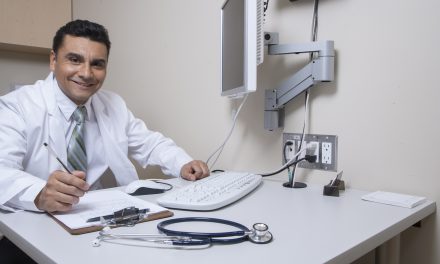
My Second Opinion

by: James Rosenberg, DC
As chiropractors, we are routinely made aware of the value of a second opinion. We often see patients who have been diagnosed and treated by a medical doctor and, especially when it pertains to a musculoskeletal condition, we disagree with either the MD’s diagnosis or treatment, or both. Our patients are most often pleased they have sought a second opinion from us.
Medical doctors’ errors, or at least disagreements amongst themselves, are surprisingly common:
A new study of 6,408 clinicians by QuantiaMD and Robert M. Wachter, MD, Professor and Associate Chairman, Dept. of Medicine, University of California, San Francisco cited that 47% of physicians surveyed encounter diagnostic errors at their practice at least monthly. 96% say they believe diagnostic errors are preventable at least some of the time and 64% of those surveyed said that up to 10% of the misdiagnosis they have experienced directly resulted in patient harm. (QuantiaMD and Robert M. Wachter, MD, 2011)
According to the study, the most common contributors to diagnostic errors include:
- Atypical patient presentation,
- Failure to consider other diagnoses,
- Inadequate patient history,
- Inadequate follow-up on test results,
- Failure to account for a symptom,
- Failure to order appropriate tests,
- Inadequate physical examination,
- Failure to refer to, and
- Incorrect interpretation of test results.
Within that same study of 6,408 clinicians, a survey conducted revealed that the majority felt diagnosis was equal parts art and science. An unnamed physician weighed in on the survey, “If it were just science, the brightest members of the medical school class should have been the best diagnosticians and it turned out they weren’t.” For that matter, if the diagnosis was only science you could input the symptoms into a computer and get your answer. The reason you cannot is that there is an art to asking the right questions, using your experience and judgment, and then knowing which of the possible diagnoses fit the clinical circumstances.
Chiropractors recognize the “art” of what we do as being an integral part of our service. We should be a standard member of the patients’ health team, utilizing our various diagnostic skills along with the skills of others to reduce the chances of missed diagnosis and, therefore, inappropriate care. The notion that any one person is supposed to be a super doctor (such as we see on TV shows) should be replaced with the concept of integrative teams.
Second Opinions Can be Lifesaving
Thomas Feeley, Vice President of Medical Operations at MD Anderson, says as much as 25 percent of patients who arrive at the center with diagnoses for certain cancers such as lymphoma may receive a different diagnosis. “When you get cancer, the first thing you may want to do is jump to get treatment with the first person you talk to,” Dr. Feeley says. “But taking the time to get a second opinion about the diagnosis you have and a careful evaluation of what treatments there are can be lifesaving.” (Landro, 2012)
According to Dr. Jonathan Schaffer, an orthopedic surgeon and managing director at the Cleveland Clinic, of the total cases reviewed through the Cleveland Clinic’s online medical second opinion program “MyConsult”, about 75 percent of the second opinions confirm that the original diagnosis was correct. In 15 percent of the reviewed cases, additional tests need to be done, and in 10 percent of the reviewed cases, the original diagnoses are “flat-out wrong.” When it came to a treatment plan, there was even more room for interpretation. Some 36 percent of the cases matched the Cleveland Clinic recommendations, while 47 percent call for minor or moderate changes. In 17 percent, the physician teams who reviewed the file completely disagreed with the originally prescribed treatment regimen. (Rubin, 2012)
Missed Diagnosis
After a systemic analysis of 31 different studies in the medical literature from 1966 to 2011 involving autopsy-confirmed diagnostic errors in adult ICU patients, Johns Hopkins researchers calculated that more than one in four patients — 28 percent — had a missed diagnosis at the time of their death. (Russell, 2012)
Health care costs are a very prominent topic in today’s difficult economic times. Some might think that second opinions are cost prohibitive, but the opposite is actually true.
Promoting true second opinions can also save unnecessary costs in a variety of ways which are often overlooked:
- Johns Hopkins Hospital in Baltimore shows legal claim payouts for diagnostic errors amount to more than $2.5 billion a year.
- Nearly half of the malpractice claims at Harvard University’s medical institutions that resulted in serious patient harm or death in the past five years resulted from diagnostic errors.2
- The Journal of the American Medical Association suggested that approximately 10 percent of all hospital deaths involve a major diagnostic error. (O’Reilly, 2010)
- One of the most widely cited studies regarding second opinions, ‘A second opinion, because there is no second chance,’ examined the impact of a mandatory second opinion for surgical pathology when cases were referred to The Johns Hopkins Hospital, a major cancer center in the United States, during a period in the mid-1990s. The study found that such a program could “result in major therapeutic and prognostic modifications,” and although the number of affected cases was not large, the authors considered that the rate of discrepant diagnoses “may have an enormous human and financial impact.” (Beishon, 2007)
- “Second Opinions in Oncology: the experiences of patients attending the Sydney Cancer Centre” investigates the frequency, goals, and outcomes of second-opinion consultations at the Sydney Cancer Centre in Australia. In this study 123 of 1,892 new patients (6.5%) stated that they were seeking a second opinion, of which 22 declined study participation, were excluded from study participation or had been referred specifically for enrollment in a particular clinical trial. Of the remaining 101 patients, 77 completed a questionnaire; 59 were women and 26 had a university degree. Reasons for seeking second opinions included: to obtain information related to treatment, for reassurance about diagnosis or treatment, and dissatisfaction with the information given by the first medical oncologist. Sixty-four patients reported that they received new information at the second opinion consultation, with 45 identifying discussions of treatment options and 34 identifying discussions of future or prognosis. Fifty-one patients reported how the second-opinion consultation differed from the first, identifying it as longer, and indicating that the oncologist answered concerns. (Tattersall, 2009)
- Second opinions in breast cancer pathology led to altered surgical therapy in 7.8% of 346 cases. (Beishon, 2007)
- A recent study found that after a decade of annual mammograms, more than half of women will receive at least one false positive recall on a breast-cancer screening. (Beishon, 2007)
Referrals
In private practice, for both new and established patients, I have increased the number of referrals to local physicians, including chiropractors, for second opinions. My experience at the hospital has taught me that many visceral cancers often present initially as back pain, including lung and pancreatic cancer, to name two in which early detection is critical to improving patient outcomes. Finding physicians who will work with your patients is not difficult and, although they may not refer to you as many of their own patients as you send to them, they will at least be supportive of your efforts to be thorough.
My radar for ruling out cancers and other visceral diseases has become more sensitive as a result of my work at Cancer Treatment Centers of America (CTCA) but, in general, we as chiropractors are in a position of seeing our patients more often than they see their medical doctors, and we generally develop a relationship of trust and open communication. Therefore, changes in the patients’ symptoms without logical cause should raise red flags for us more readily. We are in a position to make a positive difference in our patients’ lives in a variety of ways, and when it comes to second opinions regarding cancer diagnoses, as you have already read, it can be a life-saving suggestion.
According to surveys, breast cancer is the most commonly misdiagnosed cancer. In my work at CTCA, I frequently meet and treat patients who were unhappy at other treatment facilities with either the diagnostic process, treatment, or lack of individualized cancer treatment. Regarding diagnosis, it has been established that one of the best ways to avoid errors is to have physicians work in teams.
The Team Approach
At CTCA, our medical physicians not only work in teams with each patient, but we also have chiropractors, naturopaths, nutritionists, acupuncturists, and mind-body therapists, all of whom participate in both the diagnostic and treatment process with each patient. Not only are errors minimized, but consideration is given to all the aspects of the patient’s condition and needs. At CTCA, we combine conventional treatment with supportive therapies to restore and maintain the body’s health, increase patients’ ability to withstand the rigors of treatment and help patients have more strength to fight their cancer battle. Our unique Patient Empowered Care© model includes a team of experts that are able to consult with one another (breaking away from the silos that can leave room for error) to minimize errors and medical expenses.
Without exception, I treat patients every day who want to know why all of healthcare isn’t structured in the integrative model like CTCA. As Chiropractors, we need to continue to evolve ourselves within the walls of all hospitals. In the meantime, we can continue to serve our patients, including educating them regarding the value of a second opinion.
About the Author:
James Rosenberg, D.C., is the National Director of Chiropractic Services at Cancer Treatment Centers of America. He is an on staff physician at the Midwestern Regional Medical Center, treating oncology patients for over 8 years. Dr. Rosenberg earned a doctorate of chiropractic degree from the National College of Chiropractic (now known as the National University of Health Sciences). He completed his Bachelor of Science degrees in biology and human anatomy at Fairleigh Dickinson University in New Jersey. Dr. Rosenberg is a Diplomate of the National Board of Chiropractic Examiners, a member of the American Chiropractic Association, serves on the ACA integrative practice committee and a member of the Illinois Chiropractic Society.
References
- Beishon, M. (2007, January/February). A second opinion, because there is no second chance. Cancer World, 6. Retrieved 2012, from http://www.cancerworld.org/pdf/8775_CW16_14-19_GrandroundOK.pdf
- Landro, L. (2012, January 17). What if the Doctor Is Wrong. Retrieved 2012 December, from Wall Street Journal: http://online.wsj.com/article/SB10001424052970203721704577159280778957336.html
- O’Reilly, K. B. (2010, December 6). Retrieved December 2012, from Amednews.com: http://www.ama-assn.org/amednews/2010/12/06/prsa1206.htm
- QuantiaMD and Robert M. Wachter, MD. (2011). Physician Perspectives on Preventing Diagnostic Errors. Owen W. MacDonald. Retrieved from http://www.quantiamd.com/q-qcp/QuantiaMD_PreventingDiagnosticErrors_Whitepaper_1.pdf
- Rubin, B. M. (2012, May 02). chicagotribune.com. Retrieved December 2012, from Chicago Tribune: http://articles.chicagotribune.com/2012-05-02/health/ct-x-second-opinion-0502-20120502_1_second-opinions-cleveland-clinic-doctors
- Russell, C. (2012, August 28). The Alarming Rate of Errors in the ICU. The Atlantic. Retrieved December 2012, from http://www.theatlantic.com/health/archive/2012/08/the-alarming-rate-of-errors-in-the-icu/261650/
- Tattersall, D. J. (2009). Second opinions in oncology: the experiences of patients attending the Sydney Cancer Centre. Retrieved from http://www.ncbi.nlm.nih.gov/pubmed/19705981

















